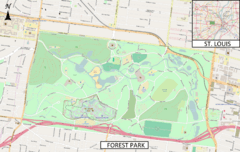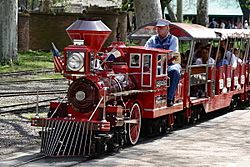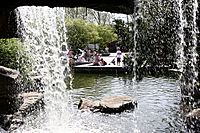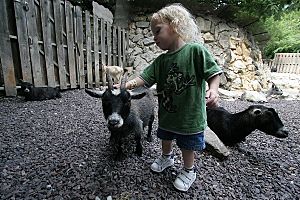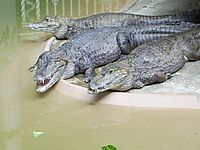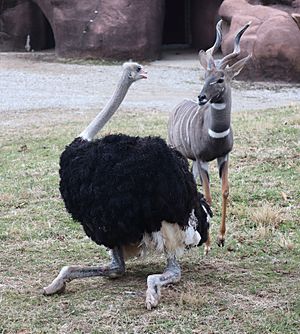Saint Louis Zoo facts for kids

Saint Louis Zoo logo
|
|
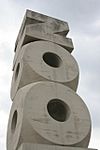
South entrance
|
|
| Date opened | 1910 |
|---|---|
| Location | Forest Park St. Louis, Missouri |
| Land area | 90 acres (36 ha) |
| Coordinates | 38°38′06″N 90°17′24″W / 38.635°N 90.290°W |
| No. of animals | 18,700 |
| No. of species | 603+ |
| Annual visitors | 3,000,000 (2016–17) |
| Memberships | AZA |
The Saint Louis Zoological Park, often called the Saint Louis Zoo, is a famous zoo in Forest Park, St. Louis, Missouri. It's known as a top zoo for how it cares for animals, does research, helps with conservation, and teaches people. The zoo is officially approved by the Association of Zoos and Aquariums (AZA).
Guess what? It's free to get in! This is because a special tax district helps pay for it. You might pay a small fee for some special rides or attractions, though. One cool thing is the 2 ft (610 mm) narrow gauge Emerson Zooline Railroad. Its trains go all around the zoo, stopping at popular spots.
The zoo's first animal exhibit was the Flight Cage. The city bought it from the Smithsonian Institution after the 1904 St. Louis World's Fair. After the zoo officially started in 1910, many new exhibits and buildings were added. These helped improve animal care and show more types of animals and their homes. The symbol of the Saint Louis Zoo is the head of a male lesser kudu, with its fancy spiraled horns.
In 2017, the Saint Louis Zoo joined forces with the Missouri Botanical Garden and Washington University in St. Louis. This partnership is called the Living Earth Collaborative. It aims to help us understand how humans can protect the different natural places where plants, animals, and tiny living things live and grow. The zoo also works on other projects, like encouraging people to use reusable bags and tracking local turtle populations.
The Saint Louis Zoo was even named the best zoo in the United States by USA Today in both 2017 and 2018!
Contents
Zoo History: How It All Started
The Early Years of the Zoo
The 1904 St. Louis World's Fair played a big part in the zoo's beginning. The fair brought a lot of attention to St. Louis and Forest Park. The Smithsonian Institution built a huge walk-through bird cage for the World's Fair. After the fair ended, the people of St. Louis decided to buy this Flight Cage for $3,500. They didn't want it taken apart and sent back to Washington, D.C. This bird cage became the very first part of what is now the Saint Louis Zoo.
By 1910, more people wanted a zoo. So, some citizens created the Zoological Society of St. Louis. In 1914, it became an official group. People had different ideas about where the zoo should be. Some suggested other parks, but eventually, the city set aside 77 acres (31 ha) in Forest Park for the zoo. A special board was chosen to manage it.
The first animals at the zoo included 51 deer and antelope, 11 buffaloes, a sacred cow, and many birds like eagles and geese. There were also prairie dogs, a camel, foxes, rabbits, and opossums.
In 1916, the number of board members grew to nine. That same year, citizens voted to create a special tax to help build the Saint Louis Zoo. It's said that this was the first zoo in the world supported by a tax from its community!
Growing the Zoo: 1920 to 1969
The zoo started to grow in 1921 when the Bear Pits were built. Then came the Primate House in 1923 and the Reptile House in 1927.
The new Bird House was added in 1930. During the Great Depression, money was tight, so building new exhibits slowed down. In 1935, the Antelope House was built with help from a government program called the Civil Works Administration (CWA). This building boom ended in 1939 with the Ape House. In 1939, the zoo even got two giant pandas named Happy and Pao Pei!
More additions came in the 1950s. The Stupp Memorial Pheasantry and the lion arena (now the Sea Lion Arena) were built in 1954. Three years later, the Elephant House was constructed.
Big construction started again in 1961 with the Aquatic House. The Emerson Zooline Railroad opened in 1963. The Charles H. Yalem Children's Zoo and the animal nursery opened in 1969.
Modern Zoo: 1971 to Today
In 1972, the zoo joined the Metropolitan Zoological Park and Museum District. This meant it received money from a public property tax. This funding helped the zoo keep improving its exhibits. Two major areas, Big Cat Country and Jungle of the Apes, were built in 1976 and 1986.
In 1989, the Living World opened. This two-story building has classrooms, a library, an auditorium, and exhibits about evolution and ecology. It also has a gift shop, a restaurant, and offices.
In 1993, the zoo received a large gift: the 355 acres (1.44 km2) Sears Lehmann farm. This farm, located west of St. Louis, is used to breed endangered species and for educational programs.
New areas continued to open in 1998 with the Emerson Children's Zoo. Phase I of River's Edge opened in 1999, featuring animals from Asia like Asian elephants and cheetahs.
In 2000, the Monsanto Insectarium (now the Bayer Insectarium) was built, including a Butterfly House. The North America part of River's Edge opened in 2001. In 2002, the third phase opened with animals from South America and Africa, such as hippos, rhinos, and giant anteaters.
The Penguin and Puffin Coast opened in 2003, with both outdoor and indoor exhibits. Also new that year was the Mary Ann Lee Conservation Carousel, which has hand-carved wooden animals that look like endangered species. The Donn and Marilyn Lipton Fragile Forest opened in 2005. Caribbean Cove, where you can see stingrays, opened in 2008. In 2015, the zoo opened Polar Bear Point, a huge $16 million home for polar bears. Its first resident was Kali, an orphaned polar bear.
The newest big update is Centene Grizzly Ridge. This $11.1 million, 7,000 square foot habitat opened in 2017. It replaced the old bear grottos from 1921. Grizzly Ridge is now home to two orphaned grizzly bears from Montana named Huck and Finley. This project was part of The Living Promise Campaign, which raised over $134 million to improve the zoo. This money also funded Polar Bear Point and Sea Lion Sound, which has a cool walk-through tunnel for viewing sea lions.
The Saint Louis Zoo is also planning a big expansion on 13.5 acres across the highway. This new area will have offices, classrooms, and year-round exhibits. It will also move all parking there, freeing up nine acres at the main zoo for more animal exhibits!
Zoo Leaders: Directors Through the Years
Here are the people who have been in charge of the zoo:
- George P. Vierheller (1922–1962)
- R. Marlin Perkins (1962–1970) – He became famous for hosting the TV show Mutual of Omaha's Wild Kingdom.
- William J. Hoff (1970–1973)
- Robert T. Briggs (1973–1975)
- Richard D. Schultz (1975–1982)
- Charles H. Hoessle (1982–2002)
- Dr. Jeffrey P. Bonner (2002–present)
Explore the Zoo: Amazing Animal Zones
Lakeside Crossing
During warmer months, you can visit Caribbean Cove. It's a shallow pool where you can touch cownose rays, southern stingrays, bonnethead sharks, and bamboo sharks. This is one of the few areas that costs money, but it's free for the first hour the zoo is open!
River's Edge: Animals from Around the World
River's Edge shows animals from four different continents.
- The South America exhibit has spectacled bears, bush dogs, capybaras, giant anteaters, and scarlet macaws.
- The African Savanna features black rhinoceros, African wild dogs, sacred ibises, bat-eared foxes, and red river hogs.
- The African Nile is home to hippopotamus, cheetahs, spotted hyenas, and dwarf mongoose.
- The Asia exhibit has adult Asian elephants and sun bears.
- The North American exhibit displays fish and wildlife from the Missouri and Mississippi Rivers, like crayfish, American bullfrogs, and channel catfish.
Discovery Corner: Fun and Learning
The St. Louis Children's Zoo is full of cool learning opportunities. You can slide through the otter pool or see birds, snakes, and frogs up close with staff and volunteers. This area also has an admission fee, but it's free for the first hour during summer. As of 2016, you can even see Tasmanian devils here!
Most of the zoo's invertebrates (animals without backbones) are in the Monsanto Insectarium. You can see amazing creatures like leafcutter ants, flower mantis, Vietnamese walking sticks, and different kinds of spiders and scorpions.
The Wild: Big Animals and Cool Habitats
The Wild area includes Grizzly Ridge, Polar Bear Point, Conservation Carousel, Fragile Forest, Jungle of the Apes, and Penguin and Puffin Coast.
- Polar Bear Point is home to Kali the polar bear.
- Grizzly Ridge opened in 2017 and houses two grizzly bears named Huck and Finn.
- The Fragile Forest and Jungle of the Apes feature gorillas, chimpanzees, and orangutans in natural outdoor settings.
- Penguin and Puffin Coast displays many water birds like Humboldt penguins, King penguins, rockhoppers, gentoo penguins, and horned puffins.
- You can also find red pandas and black-tailed prairie dogs in The Wild.
Historic Hill: Classic Zoo Favorites
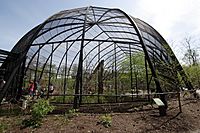
Historic Hill has the Bird House, Bird Garden, Sea Lion Sound, Herpetarium, Chain of Lakes, Flight Cage and Cypress Swamp, and Primate House.
- The Bird House has many different birds, from bald eagles to kookaburras. You can even see the Guam kingfisher, which is extinct in the wild (meaning it only lives in zoos now).
- Sea Lion Sound has a cool underwater tunnel where you can watch California sea lions and harbor seals swim.
- The Herpetarium is where most of the zoo's reptiles and amphibians live. This includes rare animals like the critically endangered Jamaican iguana and the Panamanian golden frog. You can also see Komodo dragons, king cobras, and giant tortoises.
- The Chain of Lakes has small areas for North American river otters and alligator snapping turtles.
- The Flight Cage was built in 1904 and was the largest bird cage ever at the time! It's still one of the world's biggest free-flight aviaries. The Cypress Swamp part is dedicated to birds from the cypress swamps of the southern Mississippi River.
- The Primate House is home to the zoo's monkeys and lemurs, including Coquerel's sifaka and ring-tailed lemurs.
Red Rocks: Big Cats and Hoofed Animals
Big Cat Country is where you'll find several types of big cats. These include the African lion, Amur leopard, Amur tiger, jaguar, cougar, and snow leopard.
At Antelope House, you can see many hoofed animals like the addax, Bactrian camel, gerenuk, Grevy's zebra, lesser kudu, okapi, and reticulated giraffe. You'll also find red kangaroos and tammar wallabys here. Some birds like the ostrich and grey crowned crane also share these exhibits.
Images for kids
See also
 In Spanish: Parque Zoológico de San Luis para niños
In Spanish: Parque Zoológico de San Luis para niños


